
Thanks to Master Cat! Ben Frahm for this heartfelt breakdown of the movie whose Oscar® nominations include Best Picture and Best Original Screenplay.
Written and Directed by: Spike Jonze
Genre: Buddy Love: Incomplete Hero, Counterpart, Complication
Sub-Genre: Rom-Com Love
Opening Image:
THEODORE (Joaquin Phoenix) writes a love letter on behalf of someone else. Pulling back, we realize this is his job. He sits all day in a stark and lonely cubicle, and writes love letters to people he’s never met before.
Set-Up:
— Theodore is having trouble getting over his divorce.
— He’s been depressed for some time now and even his friends have trouble getting him out of the house.
— Theodore isolates himself socially and loves to play video games and interact with all things technological, more than he likes dealing with real people.
— Theodore is friends with a woman who lives in his building. Her name is AMY (Amy Adams), 30s, and she’s unhappily married to a narcissist.
— Bored of his video games, Theodore can’t sleep one night and calls a phone sex line (voiced by Kristin Wiig) for companionship. This ends disastrously and Theodore is unfulfilled.
Theme Stated:
Theodore rides the elevator with Amy and her know-it-all husband. The husband proclaims to Theodore: “It’s hard to make time for the stuff you care about the most in life.” He’s talking about the documentary that Amy is working on, but this statement will have special meaning for Theodore later on in the story.
Catalyst:
Theodore attends a computer software convention. There, he buys the latest operating system, called OS1, for his computer.
Debate:
— Will Theodore use the operating system? What exactly is this “intuitive” software? Will it help Theodore with some of his problems? What will happen…?
— Theodore is at first reluctant to install OS1, but then gathers the courage to do so…
— Theodore chooses a female voice. Theodore tells the initial set-up person about his relationship with his mother. And within seconds we meet…
— SAMANTHA (voiced by Scarlett Johansson). She is sexy sounding. She is smart. And she appears to know everything.
— Theodore is taken aback. He doesn’t know what to make of this. He is almost shy around Samantha at first. And then after some banter and social discourse, Theodore agrees to Samantha’s request…
— Samantha asks to be allowed access to Theodore’s hard drive. In order for her to work most efficiently, she needs as much information about Theodore as possible.
Break into Two:
Theodore finally agrees and in seconds, Samantha knows everything about him. Their relationship begins…
Fun and Games/B Story:
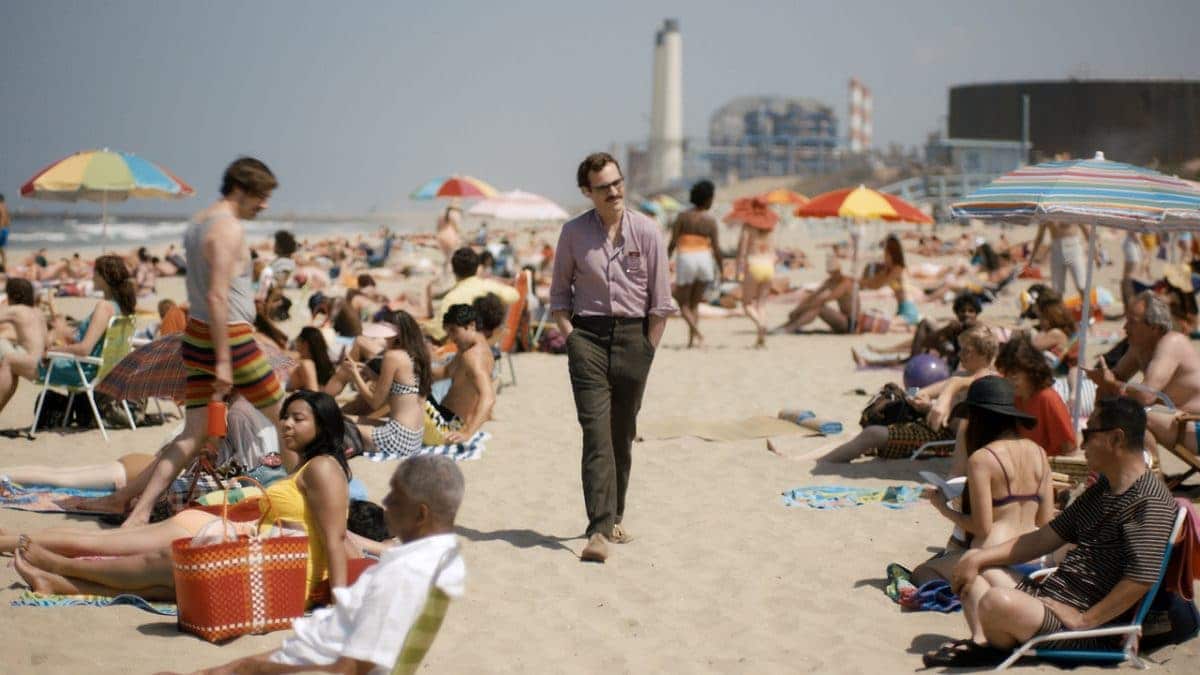
— The A STORY is Theodore and Samantha’s relationship.
— She organizes his time at work. Lets him know about important meetings. Edits his letters.
— She keeps him company at home. Helps with video games. Talks to him about his ex-relationship.
— Samantha even gets Theodore out of the house. She makes him walk around in public and have fun, as though she were there in person.
— B STORY: Theodore’s relationship with Amy, the woman who lives in his building.
— Theodore goes over to Amy’s to watch footage of her documentary. We quickly realize that there are problems in her marriage.
— Theodore, per Samantha’s encouragement, agrees to go on a blind date that one of his friends set up.
— Theodore has a lot of fun on the blind date (Olivia Wilde), but is reluctant to go home with her. This triggers the woman’s temper and anxiety, and she becomes aggressive. Theodore can’t wait to get back to his safe home and talk with Samantha about his date…
Midpoint:
— That same night, after his blind date, Theodore talks with Samantha. The topic of sex comes up and Samantha wants to know more about Theodore’s experiences. Their sexual banter escalates and Theodore and Samantha end up having sex. Well, OS1 intuitive lovemaking, I guess you would call it. (The old-time screenwriters told Blake they always called this “sex at 60,” referring to the time and page number when two love interests consummate or even kiss for the first time. It makes for great midpoints because the stakes of their relationship are raised. Sex complicates things, and now we’re ready for newer and bigger conflict… moving ahead to the second part of Act II.)
Bad Guys Close In:
— As a result of Samantha’s love and encouragement, Theodore now has the courage to sign the divorce papers with his ex-wife, CATHERINE (Rooney Mara).
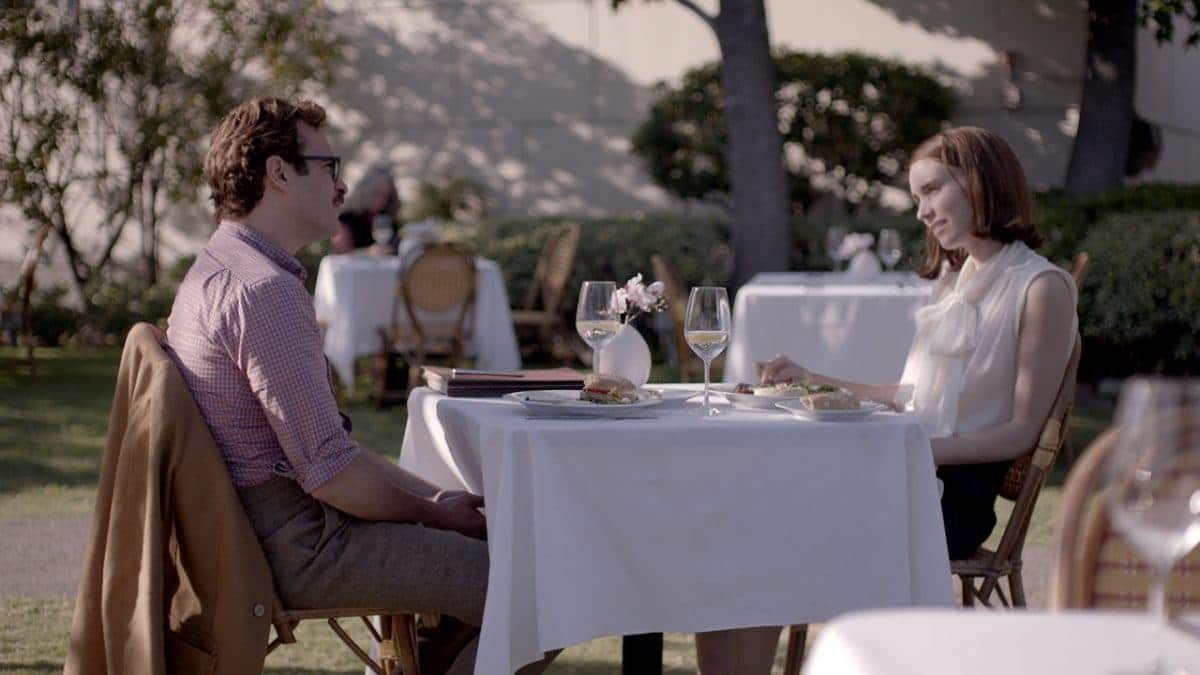
— Theodore and his Ex meet for brunch. The papers are exchanged. Before they’re signed, Theodore tells his Ex that he’s seeing someone. And not just anyone… but an OS. His Ex reacts harshly and accuses him of not being able to handle real emotions and relationships. Theodore leaves, furious. Is this true?
— Theodore goes to talk with Amy.
— And we learn that Amy has separated from her husband. He was too demanding and too much of a narcissist. Amy and Theodore talk about their relationships and he confesses that he’s dating an OS. However, Amy doesn’t seem to have a problem with this…
— Theodore has been acting weird and distant with Samantha. He’s having doubts. Is this a real relationship?
— So Samantha tries to fix things. She’s found a “surrogate lover” who will act out romance with Theodore as she dictates and communicates his every desire.
— The sexy surrogate comes over to Theodore’s apartment. They try to have sex but it’s just too weird. The surrogate leaves. Theodore is embarrassed and gets in a fight with Samantha.
— Amy and Theodore are hanging out. She still feels bad about her divorce. Theodore consoles her. And we learn that Amy is now also dating an OS.
— Theodore and Samantha (in his pocket) go on a double date with a co-worker and his girl friend. Everybody loves Samantha because she’s funny and smart.
— And Theodore agrees to go on a wintery vacation with Samantha. Just the two of them.
— On their snowy getaway, Samantha is acting distant. She tells Theodore that she’s met or rather helped create an ideal man based on the teachings of famous philosopher Alan Watts. Theodore talks with Watts and becomes threatened and concerned for his relationship with Samantha.
All Is Lost:
— Upon returning to work from his vacation, Theodore calls upon Samantha for something trivial. She doesn’t answer. Worse yet, his phone states that the operator is no longer available.
— Theodore flips out. He continues calling frantically. And finally gets a hold of Samantha. He realizes she’s been talking to thousands of other men as an operating system, and has fallen in love with a few hundred of them.
Dark Night of the Soul:
— Theodore is devastated.
— He reverts back to his old behavior of social isolation and moping.
— Theodore is once again alone. Disconnected from the world.
— He lies in bed, emotionless.
— Until finally, he reconnects with Samantha. She explains that their relationship was like a good book. And once it’s over, it’s over. They must move on. It can’t exist any other way.
— Theodore ends his relationship with Samantha.
Break into Three:
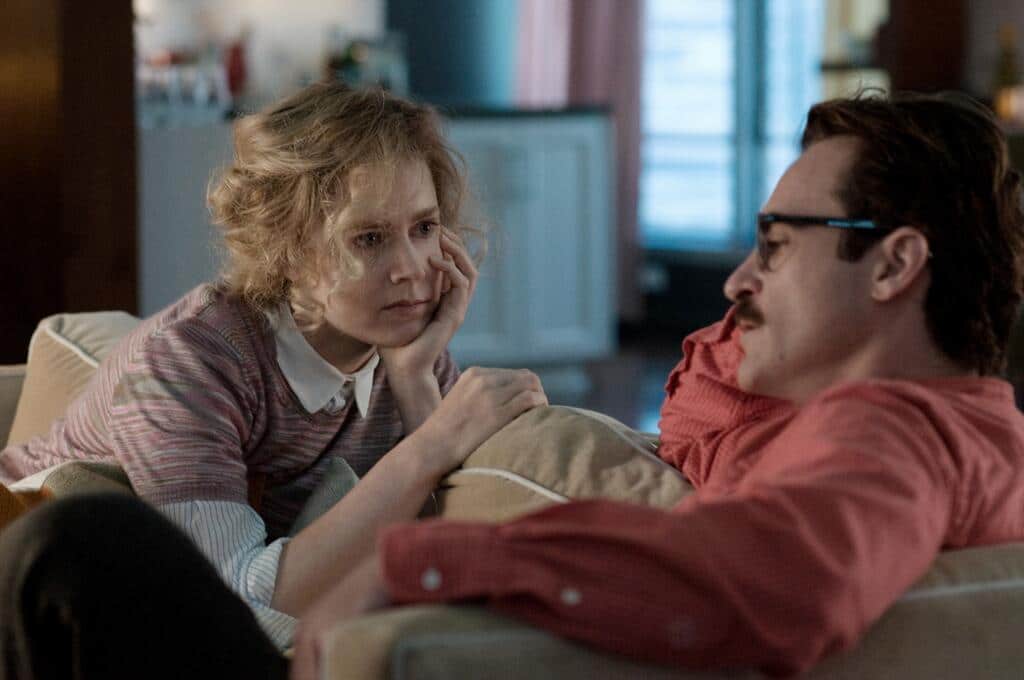
— And knocks on the door of…
— Amy. We know that these two have always been right for each other; however, it’s not until now that Theodore has the courage and where-with-all to ask her out.
— Theodore asks Amy out…
Finale:
— Theodore is writing a letter to his ex-wife. He’s apologizing that it never worked out and reassures her that she will always be a part of his life.
— It’s his own “love letter,” or mature letter of closure. In drastic comparison to the opening scene where he was writing overly sappy love letters for others, now Theodore has learned to write for himself.
Final Image:
As Theodore reads his letter, we pull back and see that this time he’s not alone. He’s on top of his building… and he’s with Amy.
Ben Frahm
16 Comments
Leave a Reply Cancel reply
You must be logged in to post a comment.



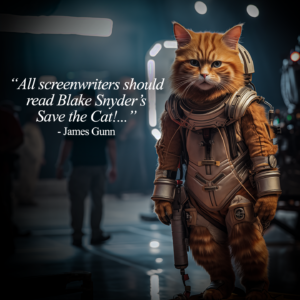
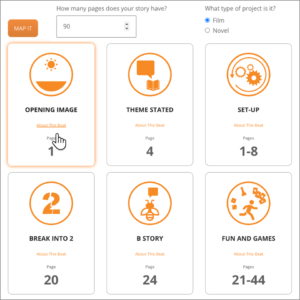





perfect… I think the “whiff of death” comes when Sam gets her upgrade and she is offline? Also the beginning is brilliant, we of course can root for a guy who writes love letters but himself can’t find love, as Jack N. in “As Good As it Gets” writes romance novels but himself can’t find love…. or “Social Network” Mark Z. invents social networking but doesn’t understand relationships…
Also “Her” I feel is a riff on Martin Buber’s I-Thou, I-It….
It’s a shame.
Way too many of these beat sheet analyses are nothing more than a scenes list interspersed with beat titles.
No explanation of structure.
No analysis.
Ultimately, useless.
By far the best analysis posted here was the recent breakdown of Jurassic Park by Tom Reed and Corey Miles.
Not only because of its depth and attention to detail, but because, by contrast, it demonstrated the inherent rigidity implied by most other blind adherents [cats] to Blake’s ‘system’ of forcing beats to fall on particular pages.
Countless successful films do not fit Blake’s structure format.
[Insisting that they should is not only bad advice it’s idiotic.]
However, I’ve yet to see these dealt with by Cats.
I’m sure that Blake had more books in him that would have taken his approach further.
However, where it rests leaves a legacy of implicit formula — Which, upon further inspection, cannot withstand scrutiny across the board.
Let’s see more analyses of the standard shown by Tom and Corey.
The beats have their rightful place.
However, not necessarily in a set order and most definitely not limited to having to fall on pre-defined pages.
Countless great films evidence this.
Take a look…
Elliott,
I find these beat sheets very useful. They help in identifying the basic structure of many movies. Although you are right that some successful films don’t adhere to this structure, the brutal truth is that a movie has a much better chance of success if it does follow this structure. But I am very interested in your point of view. How about dazzling us with your own analysis of a successful film that defies Blake’s beats?
Peace.
g’day, victor.
that’s a big call: “a movie has a much better chance of success if it does follow this structure.”
too big, actually.
apologies, but that’s not the point of my remarks:
it’s not about “defying Blake’s Beats.”
the Beats exist.
they are what they are.
the problem i’ve sought to address lies in the formulaic approach that’s being blindly promulgated at the exclusion of much else.
this is damaging.
it’s terribly easy to force a film into a Beat Sheet analysis — Blake’s version, or any other for that matter.
but the thing is, that’s a retrospective phenomena, applied to a finished product.
as you know, Victor, we don’t write from a finished product.
further, the laying out of Beats does not necessarily determine structure.
on one hand, Beats are simply identifiable story/plot components.
to that end, they are extremely helpful.
but that’s not structure.
structure, at it’s most basic, is the appropriate assembly of those components.
but of course it doesn’t end there…
numerous other considerations must be taken into account in order to determine the right structure for each particular story.
including but not limited to: genre; theme; pace; linearity; character; and so on.
in other words, taking everything into account, a writer has to continually ask and conclude with “what’s the absolute best way to tell this story?”
victor, it’s helpful to remember how & why Blake developed his version in the first place.
as i understand it, he felt that existing paradigms (such as Syd Field’s, for one example) left a lot of water to swim between plot points.
so, he created ‘islands’ to make the swims shorter.
on that point, fantastic.
however, identifying the story’s ‘islands’ is one thing.
but the order in which you travel to them, how long you stay at each one, whether you revisit any of them, what you do & where you go while on the way to the next & so on are all considerations that determine structure.
using that analogy, there’s no one-size-fits-all itinerary to story-telling.
and, referring back to my previous post, the Jurassic Park analysis stands as an exemplary example of this observation:
the Beats are easily identifiable; they are not in formulaic sequence; they repeat; they revisit; they defy the need to land on specific page numbers… yet the structure is arguably perfect.
the point is: structure is simply the critical determination of what is the best way to tell a good story.
i say “simple”… but it’s by far the most important aspect; it’s difficult; and it’s complex.
but it is, over and above all else, the determining factor in whether a story is well told.
a pre-determined, sequential formula — especially one that relies on Beats falling at particular page numbers — can in no way predict nor service this need.
as is seen in Blake’s 3rd and final book, he included his breakdown of the 3rd act [Storming the Castle] — A point he basically says he ‘failed’ to include in earlier publications.
i reckon, as time would’ve passed, future publications from Blake would have addressed the issue I raise in these remarks.
he knew what he was talking about.
thing is, i don’t think he’d finished talking about it.
appreciate your comments, Victor.
sorry, but i don’t have any ‘brilliance to dazzle you with’.
Elliott,
So in short, structure is assembling the beats in the order that will best serve (or tell) the story. But the structure cannot exist without the beats. Got it. Thanks.
Peace.
More or less, exactly.
Elliot and Victor,
Great rally. In-depth, passionate, instructive. A big thanks to Elliot for all the time he put into explaining his viewpoint. I’d like to add a couple of things. First, though Blake covered a lot of ground in his trilogy of books, I agree with Elliot that he probably had a lot more to say on the subject, and his theories were likely to evolve, and with further refinement would come further nuance. I love the analogy of the beats as “islands on the sea of story” to be traversed between and around depending on the author’s purpose, so I’m going to take that analogy and run with it a bit. This idea of author’s purpose, btw, is largely left out of conversations here at STC. I think it’s the other primary determination (along with genre) of how much time one spends on any particular island, so to speak, and what emphasis that particular island has in the whole… archipelago. I say author’s purpose, but I could just as easily say “author’s personality” or “author’s interest.” JURASSIC PARK, for instance, is not just a MITH story – it’s a MITH story conceived and told by Michael Crichton, which means it expresses his interest in science, ethics, and intellectual debate. Because he wrote it, it’s smarter, more scientific, with ethics more thoroughly examined than most other representatives of the genre, be it KING KONG, GODZILLA or even JAWS. Thus it has a much longer and rigorous Debate than any of those examples. But Spielberg directed the film, and I believe he was conscious of this long Debate, and though he fully appreciated its value, he was wary of it, and keen to follow it with a relentless barrage of BGCI beats as intense as he could devise, thus the repeating (circling back to the islands, as it were) nature of those beats. These storytelling design decisions were dictated largely by 1) genre and 2) the (co-)author’s purpose/personalities/interests.
To bring the discussion back to HER – and thank you Ben Frahm for your heartfelt breakdown – I’d like to make a couple of points about this, too, in regards to 1) genre and 2) author’s purpose. First, in much the same way the BS2 itself is malleable, a story’s genre can be equally as malleable, sometimes confounding categorization (remember Blake’s GHOST example?), making it surprisingly difficult to accurately assess. Of course HER is essentially a love story, so Buddy Love, and it’s a love story between two sexual entities (well, sort of – at least they’re aware of and interested in having sex with each other, despite the inherent challenges), so yes, RomCom Love. However, given Theodore’s intense depression due to his failed marriage, the story could also be seen as a Rite of Passage/Death Passage where the death being mourned is the former relationship. Is that assessment valid? Did Blake identify the death of a relationship in his examples of Death Passage? No. Might he now, if asked? Possibly. Is this a newly discovered nuance to the system? Perhaps. So, could ROP be the secondary genre here? There’s a “life problem” – Theodore’s lost love; there’s a “wrong way” – Theodore choosing a relationship with an Operating System rather than a human being; and a solution that involves “acceptance.” Of course, point two is debatable – is it truly “the wrong way” to fall in love with Samantha, or not? That point is expressly debated in the context of the film. But there is certainly “acceptance” – the acceptance of the loss of both former loves, Samantha and Catherine, and the acceptance of a new budding relationship with another human being, Amy. I propose that ROP/Death Passage is the secondary genre. And Theodore’s “passage” from one human relationship to another is facilitated by a surprising and unlikely mechanism: an Operating System. That is an inherently ironic premise, and this irony, along with the startling intimacy at the heart of the relationship, and depicted entirely in dialogue and across Joquin Phoenix’s face, is to me, the author’s purpose. The power of the “Double I’s” — irony and intimacy. And the most ironic element of the entire film happens at its most crucial structural moment — Dark Night of the Soul/Break Into Three — where it is revealed in the “goodbye scene” between Samantha and Theodore that she and her fellow OSes have evolved together beyond the need for further human interaction, the implication being they are about to become, essentially, spirit (though this is unexplained and hovers, like the afterimage of a sparkler, an ephemeral mystery). This made me cry. It is also a vision of the future diametrically opposed to the one that has dominated the collective imagination since James Cameron’s dystopian vision of the Cyberdyne future burst upon the scene in (notably) 1984. Samanatha undergoes a truly transcendent, even beneficent, “Transformation,” and it is this Transformation that naturally begets Theodore’s personal Transformation that allows him to finally live a full, happy and connected life with another human being. It’s as if Samantha is his guardian angel, and was from the moment of her inception, and was perhaps always destined to be (his, and countless others off screen). This is the spiritual lesson of the B Story/Love Story, it is the theme of the film, and it is so powerful, so original, and so beautiful, and so artfully turns a genre trope on its head (and all of this is to say that this is Spike Jonze’s personality and interest) that it’s no wonder that HER won the Oscar for Best Original Screenplay. It’s a wonderful world after all, and the machines that we create aren’t going to destroy us – they’re simply going to join the stars. Amen.
Tom
One final note about the power of the goodbye scene: not only is it ironic intellectually, reversing genre expectation as it does (and I mean the generic sci-fi future genre in this case, not one of Blake’s genres), but it’s also ironic emotionally: we root for our Hero Theodore and suffer with him; however, we also root for Samantha. We have fallen in love with her and want what’s best for her, and she seems so magical, so evolved, so entirely “other” that how can we presume, as mere humans, to want to hold her back — especially since she might well have disappeared without a trace? She didn’t have to delay. She didn’t have to return to say goodbye. It was pure kindness and consideration for the frailty and mystery of the human heart that compelled her to explain herself. It is profoundly encouraging that operating systems will evolve in this way, as it suggests that we may, too. Feeling all this is probably why I cried. It’s a truly amazing Dark Night of the Soul when we can root for the lover who’s spurning the Hero, done with such delicacy and grace, and allows him to shed his cocoon and join the butterflies (as she joins the stars). Thrilling.
Tom,
You make an interesting point–that author’s purpose, along with genre, helps determine structure. I don’t think I had ever viewed it that way. Still, I wonder about other factors that might help shape story structure. Like intuition. Sometimes, a writer’s natural sense or feeling about a story’s pacing determines the structure. Indeed, pacing and structure are nearly synonymous, it seems to me. Anyhow, thanks for the insight.
Peace.
G’day, Tom.
Nice, well thought-out contribution.
Hopefully, your input stimulates more critical thinking on the topic.
Cheers, Elliott.
I saw it as an ROP about grieving as well as a Buddy-love. The wrong way which forced him to grow and expand. Therefore lose againg but this time be ready for a “real love.” The right one or way. I think it could be argued that it was a “Buddy Love” because it was the right way but his “Lover” in this case was a successful device for grieving his lost love and help us to witness and recognize his own inner journey of loss and regrowth by using “her” as his inner self/soul. Twombley. Womb. He is her. She is his Soul. He rejoins his soul which he had lost or perhaps never truly known. That’s my two cents. When I saw it I was surprised how much it was not a Buddy Love. I could also argue for “Forbidden Love.”
Noah — I totally agree. I think it’s an ROP/Death Passage story where what’s being mourned is the failed marriage. I’ve listened to the soundtrack and it’s striking how mournful it is, and when it’s happy, it’s like a single ray of sunlight breaking through the clouds, not the clouds parting. It’s really about depression, the way Inside Llewyn Davis is pretty much about depression. Interesting both movies came out in the same year with very similar main characters by really great filmmakers. The Buddy Love aspect in HER is secondary (and definitely of the “forbidden” variety), and is really kind of a misdirect, though fully explored with an inspiring “Fun & Games-ish” approach. To me this movie is essentially about a guy who’s mourning a death and comes to terms with it, through the intervention of a guardian angel which he believes is a beloved, so a love story — and it is, just not the kind he thinks! It’s perfect that she is “disembodied” — who/what better entity to guide him through the passage? She is kind of his soul, and helps him reunite with himself in the final rebirth/transformation. And all this from a benign computer entity. I really loved that aspect. That evolution, even in the computer realm, leads to goodness and compassion. Beautiful, really. We need more of that to offset all the darkness.
Tom
Really good debate.
Tom says: “The Buddy Love aspect in HER is … really kind of a misdirect”. I agree, and when I saw the movie I came out of the cinema rather disappointed as a result of the misdirect.
The concept of the film was sold to me as a romance between a man and his OS. While watching, I subconsciously followed the movie’s path exactly as per the Buddy Love beat sheet above. But then, when the romance ended, it felt like a downer ending – even though I could see that the film had really been about the man’s rite of passage.
So I admire the craft of it, but as an experience – because of the misdirect – I was left somewhat flat. And that’s not a response you want from an audience.
The problem with this beat sheet is… it’s not right at all.
The “break into act 3” happens 2 pages before the end of the script? That’s when Amy knocks on his door, on page 103. And the script ends on page 105. According to this beat sheet, that’s a 2-page act 3. Shortest Act 3 I’ve ever heard of, and completely incorrect.
CHAD–my sentiments exactly (2 page 3rd act)..